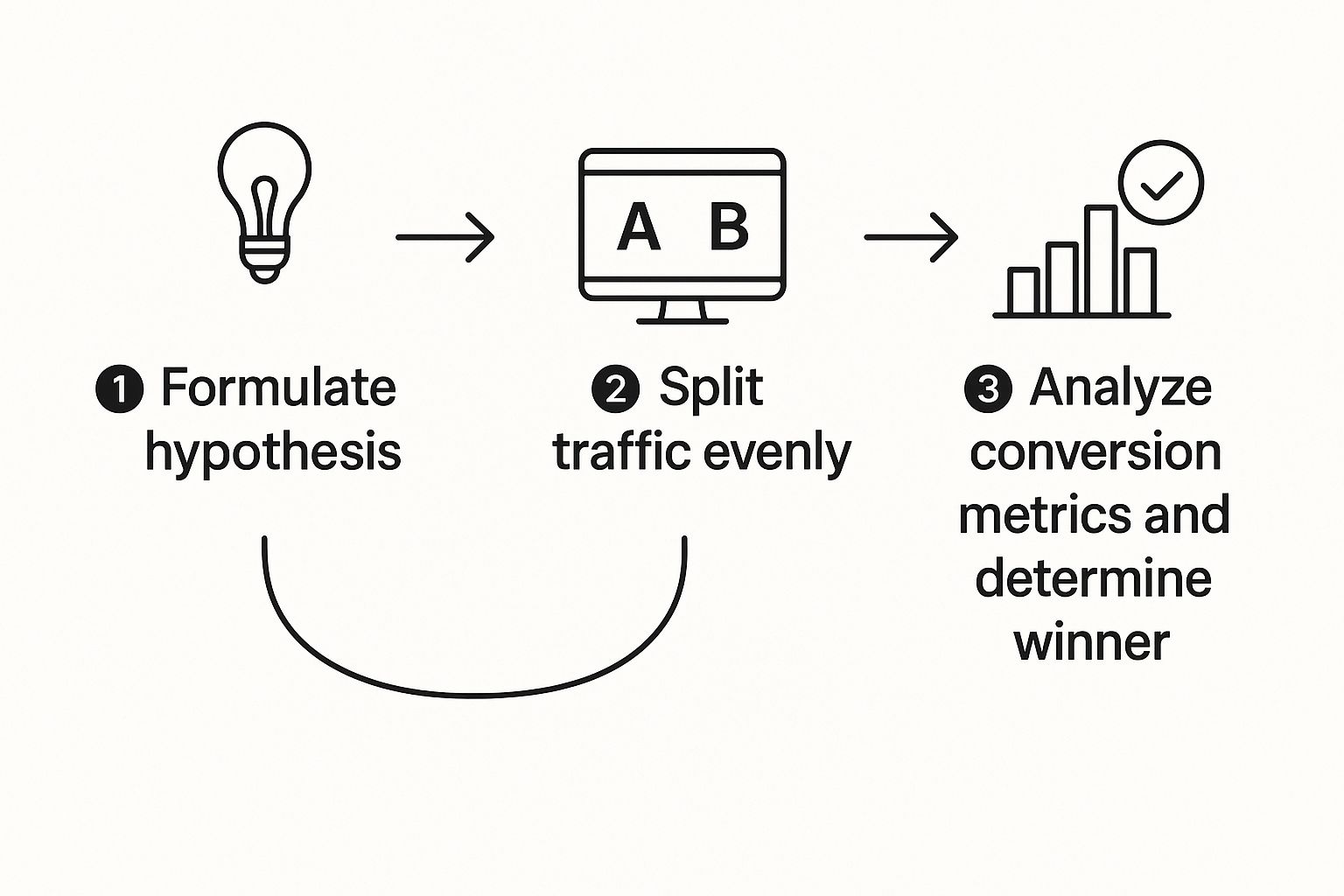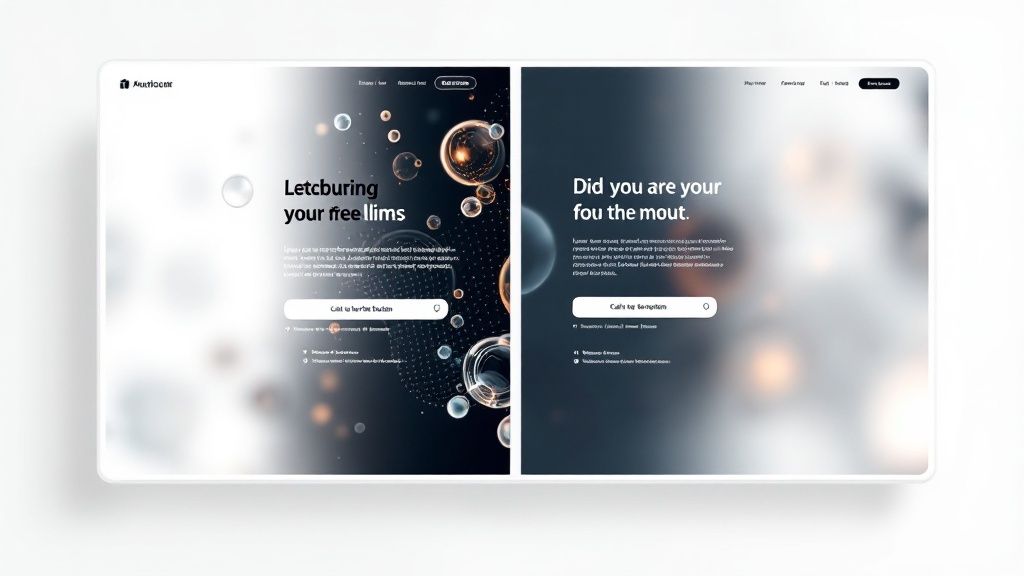
Are you looking at your website analytics, seeing a steady stream of visitors, but wondering why sales or sign-ups remain flat? It’s a common challenge for digital marketers and creators. The secret to growth isn't always about getting more traffic; it’s about getting more from the traffic you already have. This conversion rate optimization guide is designed to help you do just that by turning casual browsers into loyal customers.
What Is Conversion Rate Optimization Anyway?
Think of your website as a physical store. You can spend a fortune on ads to get people through the door, but if the layout is confusing or the checkout line is a mile long, most people will leave empty-handed. Conversion Rate Optimization (CRO) is the art and science of perfecting that digital experience for your visitors.
At its core, CRO is a systematic process of understanding how users navigate your site, what actions they take, and—most importantly—what’s stopping them from converting. It relies on data and user feedback, not guesswork, to make meaningful improvements that drive business goals.
Why CRO Matters More Than Ever
Acquiring new customers is expensive. CRO is powerful because it focuses on maximizing the value from the visitors you’ve already paid to attract, making it one of the most cost-effective ways to grow your revenue. Even small, data-backed tweaks can lead to significant wins.
These changes often involve:
- Rewriting a confusing headline or a weak call-to-action (CTA).
- Streamlining a clunky checkout or sign-up form.
- Building trust by adding customer reviews or testimonials.
- Improving your site’s loading speed so users don’t get frustrated and leave.
For online stores, this ultimate guide to e-commerce conversion rate optimization is a fantastic resource that dives deep into tactics specific to that world.
The goal is simple: make it as easy and intuitive as possible for a motivated visitor to become your customer. Every single barrier you remove, no matter how small it seems, can help nudge your conversion rate in the right direction.
How To Measure Your CRO Performance

Before you can start improving your website, you need a baseline. Trying to do CRO without solid data is like navigating a ship in the dark—you're just guessing. The first and most fundamental metric is your conversion rate: the percentage of visitors who complete a desired action.
It’s surprisingly simple to calculate:
Conversion Rate = (Total Conversions / Total Visitors) x 100
For example, if a landing page for your agency gets 5,000 visitors and 100 of them fill out your contact form, your conversion rate for that goal is 2%. This simple equation is the starting point for any real optimization work.
What Is a Good Conversion Rate?
This is the million-dollar question, and the honest answer is: "it depends." There’s no magic number that works for every business. A "good" conversion rate is relative to your industry, traffic source, and the specific action you’re measuring.
For context, recent data shows the average conversion rate across all industries hovers around 2.9%. But that’s just a blurry average. For instance, traffic from paid search ads often converts well (3.2%), while a marketing agency in the B2B services space might average closer to 2.7%. The most important number is your number. Your primary goal should always be to improve upon your own baseline.
Average Conversion Rates by Industry and Traffic Source
To give you a clearer idea of where you might stand, here’s a quick summary of benchmark conversion rates. Use this table not as a strict target, but as a way to get a feel for your performance relative to your sector.
| Industry / Traffic Source | Average Conversion Rate |
|---|---|
| Healthcare | 5.3% |
| Direct Traffic | 3.3% |
| Paid Search | 3.2% |
| All Industries (Overall) | 2.9% |
| B2B Services | 2.7% |
Remember, these figures are just averages. Your own results will be unique, but knowing the general benchmarks can help you set realistic goals for your CRO efforts.
Key Performance Indicators Beyond Conversion Rate
Your conversion rate tells you what happened, but it doesn't tell you why. That's where other Key Performance Indicators (KPIs) come in. Think of them as clues that help you understand the story behind your main number.
Here are a few of the most critical KPIs for marketers to watch:
- Bounce Rate: The percentage of people who land on a page and leave without doing anything else. A high bounce rate often signals a disconnect between your ad copy and your landing page.
- Average Session Duration: How long are people sticking around? Low duration could mean your content isn't engaging or the site is confusing to navigate.
- Cart Abandonment Rate: A crucial metric for e-commerce. It tracks how many shoppers add products to their cart but leave before paying, often due to unexpected shipping costs or a complicated checkout.
Digging into these metrics is essential for making smart, data-driven decisions. For a deeper look, our guide on how to measure content performance provides additional valuable frameworks.
👉 Try MediaWorkbench.ai for free – schedule your posts and generate AI content in one place!
A Repeatable Framework for CRO Success
Great conversion rate optimization isn’t about guesswork; it's a disciplined, scientific process that methodically turns data-driven insights into business growth. By adopting a structured framework, you move away from relying on luck and start building a system for consistent, repeatable results. Think of this process as a continuous cycle where every test fuels the next round of improvements. It’s not a one-time project; it's a core business practice.
Step 1: Research and Analysis
This is where you become a digital detective. Before you can fix a problem, you have to find it. This phase is all about gathering quantitative (the "what") and qualitative (the "why") data to understand how people are really using your site and where they're getting stuck.
- Quantitative Data (The "What"): Tools like Google Analytics provide the hard numbers. They tell you what is happening—which pages have the highest bounce rates or where users drop off in the funnel.
- Qualitative Data (The "Why"): Now you need to understand why it's happening. Tools like Hotjar provide heatmaps and session recordings, allowing you to see where users click, scroll, and hesitate, revealing moments of confusion and friction.
You can also learn a lot by looking at your competition. Our guide on how to conduct competitor analysis is a great resource for spotting opportunities in your market.
Step 2: Formulating a Hypothesis
Once you’ve identified a potential problem, it’s time to make an educated guess about how to fix it. This is your hypothesis—a clear, testable statement that follows a simple formula:
"If I [make this specific change], then [this specific metric] will improve, because [this is the reason]."
For example, a marketing agency might hypothesize: "If we change the CTA button on our services page from 'Learn More' to 'Get Your Free Proposal,' then lead form submissions will increase, because the new copy is more specific and value-driven."
Step 3: Prioritization and Testing
You'll likely have a long list of hypotheses, so you need to prioritize. The PIE framework is a popular method for scoring each idea based on its Potential, Importance, and Ease of implementation. Once prioritized, you're ready for A/B testing (or split testing). You create two versions of a page—the original (Control) and your new version (Variation)—and show each to a segment of your audience to see which performs better.
This infographic breaks down the basic flow of an A/B test.

This process ensures your decisions are backed by actual user behavior, not just an opinion. For more complex scenarios, multivariate testing allows you to test multiple changes at once, but it requires significantly more traffic to get reliable results.
Step 4: Learning and Iterating
After a test concludes, you analyze the data. Did your new version win, lose, or make no difference? No matter the outcome, you've learned something valuable.
- If your hypothesis was correct: Implement the winning change and use that insight to shape your next hypothesis.
- If your hypothesis was incorrect: This is not a failure. It's a crucial learning opportunity that gives you data on what doesn't work for your audience, which is just as valuable.
The entire process is a loop. Insights from one test become the foundation for the next, creating a powerful cycle of continuous improvement.
Building Your Essential CRO Toolkit

You can't fix what you can't see. Any serious conversion rate optimization guide must cover the tech that makes it all possible. The right tools separate data-driven decisions from guesswork, giving you the insights and testing power you need. Think of your CRO toolkit like a diagnostic set, with each tool helping you look under the hood of your website. I find it helpful to break the essential tools down into four main categories.
Analytics Platforms: The "What"
First, you need to know what’s happening on your site. Analytics platforms deliver the hard, quantitative data, tracking big-picture metrics like page views, bounce rates, session duration, and goal completions.
- Google Analytics: The industry standard. It's free, powerful, and gives you a deep look into user demographics, behavior flows, and conversion tracking.
- Adobe Analytics: An enterprise-level solution offering granular segmentation and real-time data analysis for handling massive amounts of traffic.
User Behavior Tools: The "Why"
Once analytics tells you what happened, user behavior tools help you figure out why. They add the qualitative story by showing you exactly how people interact with your pages.
- Heatmaps: Create a visual overlay on your pages showing where people click, move their mouse, and how far they scroll.
- Session Recordings: Let you watch anonymized recordings of real user sessions as they navigate your site, providing priceless context. Tools like Hotjar and Crazy Egg are leaders in this space.
A/B Testing Platforms: The Experiment
With your data and a solid hypothesis, you need a platform to run a controlled experiment. A/B testing platforms make it easy to show different page versions to different audience segments and see which one performs better, ensuring your decision is based on statistical proof.
- Leading platforms here include Optimizely and VWO (Visual Website Optimizer).
User Feedback Tools: The Direct Ask
Sometimes, the easiest way to understand what your users want is to simply ask them. User feedback tools let you collect direct, qualitative insights straight from the source.
- On-site Surveys: Short, pop-up surveys that appear at just the right moment (e.g., asking about checkout friction).
- Feedback Polls: Simple one-question polls to get a quick pulse on user sentiment.
- Tools like SurveyMonkey and Qualaroo are excellent for this. Combine these insights with smarter content using our guide on how to use AI for marketing.
Proven CRO Strategies to Implement Today

Now let's explore high-impact tactics you can start testing immediately. These aren't just theories; they're battle-tested strategies that consistently move the needle for marketers, creators, and agencies. This is your playbook for turning more website visitors into loyal customers.
Optimize Your Calls to Action
Your Call-to-Action (CTA) is the final doorway a visitor must walk through to convert. Effective CTA optimization involves methodically testing the core components that drive a user to click.
- Copy: Test action-oriented phrases like "Get My Free Quote" against something generic like "Submit." For a creator selling a course, "Enroll Now and Start Learning" is more compelling than "Buy."
- Color and Contrast: Your button needs to get noticed. Test high-contrast colors that draw the eye while aligning with your brand’s design.
- Placement: Is your CTA clearly visible above the fold? Experiment with different locations to find the most intuitive spot.
Struggling to find the right words? Brushing up on some copywriting tips for beginners can give you a great starting point.
Simplify Your Forms
Every field you ask a user to fill out is a potential roadblock. These are notorious conversion killers. Your goal is to make signing up or checking out feel effortless. Challenge every field by asking, "Is this information absolutely essential right now?" If not, cut it.
- Reduce Fields: For an initial sign-up, a name and email are often all you need.
- Use Social Logins: Allowing users to sign up with Google or Facebook speeds things up.
- Enable Autofill: Ensure your forms are compatible with browser autofill features to save users time.
Leverage Social Proof
It’s human nature: we are influenced by the actions of others. This is social proof, and it's one of the most persuasive tools in your CRO toolkit. Seeing that others have had a great experience builds instant trust and reduces hesitation.
- Customer Testimonials: Feature glowing quotes from happy clients. Adding their name and photo makes them more authentic.
- Case Studies: A marketing agency can showcase a detailed story of how they increased a client's leads by 50%.
- User Reviews and Ratings: Prominently display star ratings on product or service pages. Data shows products with even a few reviews are 270% more likely to be purchased.
Improve Your Visuals
In the online world, your visuals are your product. Customers can't pick up an item or examine it up close, so your photography has to do all the heavy lifting. Grainy, poorly lit, or generic stock photos can torpedo your credibility. Investing in professional e-commerce photo editing services is a fantastic CRO strategy, as polished images give customers the confidence they need to click "buy," directly boosting conversion rates.
Conclusion
Mastering conversion rate optimization is about shifting your focus from simply acquiring traffic to maximizing the value of every visitor. By adopting a systematic framework of researching user behavior, forming data-backed hypotheses, and testing your ideas, you create a powerful engine for sustainable growth. Start with the basics: measure your current conversion rate, identify friction points with analytics and user behavior tools, and begin testing high-impact areas like your CTAs and forms. Don't let guesswork or opinions drive your strategy; let your users tell you what works.
Ready to create high-converting content for your landing pages and ad campaigns? MediaWorkbench.ai provides hundreds of AI-powered templates to help you write copy that turns visitors into customers. Start your free trial today and see the difference.

